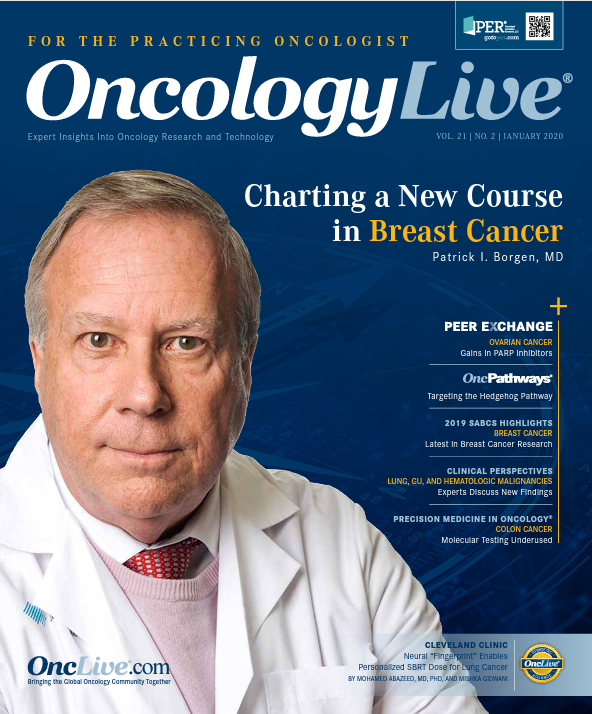Publication
Article
Oncology Live®
Patient Input Should Inform Oncology Trial Design and Interpretation
Author(s):
Even the most basic investigation into fundamental mechanisms of the development and progression of cancer in an in vitro system may generate data that, ultimately, prove vital to developing new approaches to prevent, diagnose, and treat malignant disease.
Maurie Markman, MD, editor in chief, is president of Medicine and Science at Cancer Treatment Centers of America and clinical professor of medicine, Drexel University College of Medicine

Maurie Markman, MD
The ultimate goals of cancer investigation, from the laboratory through the last stages of clinical trials, are well understood. Even the most basic investigation into fundamental mechanisms of the development and progression of cancer in an in vitro system may generate data that, ultimately, prove vital to developing new approaches to prevent, diagnose, and treat malignant disease.
Although laboratory scientists may have limited experience or background in the clinical manifestations of the illness they are investigating, it is not unreasonable to suggest that some basic knowledge of the clinical entity might inform their investigative efforts. In this regard, it is disappointing to read an abstract of a translational laboratory paper dealing with ovarian cancer in a major scientific journal (Scientific Reports) that declares: “Although 70% to 80% of newly diagnosed ovarian cancer patients respond to first-line therapy, almost all relapse and 5-year survival remains below 50%.”1
In fact, recently published studies have reported 3- to 4-year progression-free survival (PFS) rates of greater than 50% for molecularly defined advanced ovarian cancer subsets,2-4 and a recent analysis of survival from 7 highincome countries (not including the United States) noted substantial improvement in 5-year overall survival (OS) for all these countries (absolute change, 4.5%-10.1%) over the past 20 years.5
It is unclear why statements such as the one above continue to appear in high-impact scientific journals, but they are most unlikely to be helpful to patients if, when reporting provocative laboratory results, the lay media and others continue to highlight these highly questionable statements.
There is another important aspect of the patient—cancer science interface, and this is the involvement of patients in the actual design and interpretation of the investigation itself—specifically, the clinical study.
Consider, for example, the nearly nonstop debate regarding the appropriate interpretation of the outcome of advanced ovarian cancer studies, which today appropriately permit a focus on the primary trial end point of PFS rather than OS. It is important to acknowledge that my attention here on this malignancy highlights the major point of this commentary, although using PFS, as opposed to OS, as a statistically significant event to justify declaring a particular strategy’s superiority over an alternative is not limited to ovarian cancer.
In 2018, the final survival results of a phase III randomized trial that examined the addition of bevacizumab to carboplatin plus paclitaxel in ovarian cancer were reported and revealed no improvement in OS for the bevacizumab-containing regimen (delivered during chemotherapy and as a maintenance strategy)6; earlier, well-known data from the same trial indicated that this strategy resulted in a statistically significant improvement in PFS.7 The overwhelmingly likely explanation for this dichotomy is the positive impact of postprogression therapy on this specific trial’s outcome, including the observation that 39% of patients in the non—bevacizumabcontaining treatment arm ultimately “crossed over” to receive an antiangiogenic agent (with the large majority receiving bevacizumab).8 This fact has remarkably not prevented some clinicians from concluding that this approach lacks meaningful efficacy because the study failed to confirm an impact on OS.9
But why should it be the clinical investigation community that determines the clinical relevance of the study end point? Why not simply acknowledge that this is an academic debate, for which opinions understandably vary, and that the only opinion that really matters (once the regulatory agencies and payers permit access to given agents) is that of the individual patient with ovarian cancer who is considering treatment options?
What is wrong with presenting the facts, including the final study survival outcomes, the data on crossover, and the uncontrolled delivery of subsequent therapies to the study population, and then letting the patient (with the assistance of her advisers—generally, her family) decide?
A second example of the importance of the patient voice in clinical studies involves a series of trials developed by the gastrointestinal cancer investigation community, which explored the relative value of 6 versus 3 cycles of adjuvant chemotherapy for high-risk surgically resected colon cancer. In these highly relevant studies, investigators sought to determine if lowering the number of courses from the standard of care (6 cycles) would reduce clinically meaningful adverse effects (AEs)—well recognized to be associated with several established regimens in this setting—without compromising efficacy (OS).
Asking the following question, although hypothetical, emphasizes the patients’ role in the design of such studies: To establish the potential reduction in efficacy that patients with colon cancer might theoretically accept to reduce the risk of serious AEs (such as temporary or long-lasting neuropathy), would it not be reasonable to seek the opinion of individuals who had experienced such AEs while undergoing the 6 standard cycles of adjuvant chemotherapy?
A highly provocative survey of patients (n = 160) who participated in one of the several studies examining this question, which included individuals randomized to both the 6- and 3-cycle arms, generated strong evidence that calls into question the magnitude of difference in OS between the trials, which should be required to define the shorter regimen as noninferior to the longer-duration program. For example, for the 82% of individuals (n = 132) who completed the survey and had experienced symptomatic neuropathy, the consensus was to require an “extra 5% [median survival gain] beyond a 65% 5-year survival” to justify having this toxicity.10
It must be emphasized that this was a single report of a reasonable but still limited number of patients. However, a strong argument can be made that interpreting the real-world relevance of these important, large, expensive, and complex studies would have been substantially enhanced if such data had been available and appropriately employed to help prospectively design such trials. Who could reasonably object to this conclusion?
References
- Shuford S, Wilhelm C, Rayner M, et al. Prospective validation of an ex vivo, patient-derived 3D spheroid model for response predictions in newly diagnosed ovarian cancer. Sci Rep. 2019;9(1):11153. doi: 10.1038/s41598-019-47578-7.
- Moore K, Colombo N, Scambia G, et al. Maintenance olaparib in patients with newly diagnosed advanced ovarian cancer. N Engl J Med. 2018;379(26):2495-2505. doi: 10.1056/NEJMoa1810858.
- Coleman RL, Fleming GF, Brady MF, et al. Veliparib with first-line chemotherapy and as maintenance therapy in ovarian cancer. N Engl J Med. 2019;381(25):2403-2415. doi: 10.1056/NEJMoa1909707.
- González-Martin A, Pothuri B, Vergote I, et al. Niraparib in patients with newly diagnosed advanced ovarian cancer. N Engl J Med. 2019;381(25):2391-2402. doi: 10.1056/NEJMoa1910962.
- Arnold M, Rutherford MJ, Bardot A, et al. Progress in cancer survival, mortality, and incidence in seven high-income countries 199502014 (ICBP SURVMARK-2): a population-based study. Lancet Oncol. 2019;20(11):1493-1505. doi: 10.1016/S1470-2045(19)30456-5.
- Tewari KS, Burger RA, Enserro D, et al. Final overall survival of a randomized trial of bevacizumab for primary treatment of ovarian cancer. J Clin Oncol. 2019;37(26):2317-2328. doi: 10.1200/JCO.19.01009.
- Burger RA, Enserro D, Tewari KS, et al. Final overall survival (OS) analysis of an international randomized trial evaluating bevacizumab (BEV) in the primary treatment of advanced ovarian cancer: a NRG oncology/gynecology oncology group (GOG) study. J Clin Oncol. 2018;36(suppl 15; abstr 5517). doi: 10.1200/JCO.2018.36.15_suppl.5517.
- Chan J, Java J, Monk B, et al. Patterns of crossover to antiangiogenesis agents in recurrent ovarian cancer patients: an analysis of a Gynecologic Oncology Group ancillary data study (GOG#218, abstract). Gynecol Oncol. 2013;130(1):e122. doi: 10.1016/j.ygyno.2013.04.351.
- Buckanovich RJ, Rustin G, Uppal S, et al. No role for maintenance bevacizumab for up-front stage IIIc (R0) ovarian cancer. J Clin Oncol. 2019;37(29):2707-2708. doi: 10.1200/JCO.19.01650.
- Blinman PL, Martin AJ, Jefford M, et al. Patients’ preferences for 3 months versus 6 months of adjuvant chemotherapy for colon cancer in the SCOT trial: what survival benefits make longer chemotherapy worthwhile? J Clin Oncol. 2018;36(suppl 15; abstr 3602). doi: 10.1200/JCO.2018.36.15_suppl.3602.
























%20(2)%201-Recovered-Recovered-Recovered-Recovered-Recovered-Recovered-Recovered-Recovered-Recovered-Recovered-Recovered-Recovered-Recovered-Recovered-Recovered-Recovered-Recovered.jpg?fit=crop&auto=format)
%20(2)%201-Recovered-Recovered-Recovered-Recovered-Recovered-Recovered-Recovered-Recovered-Recovered-Recovered-Recovered-Recovered-Recovered-Recovered-Recovered-Recovered-Recovered.jpg?fit=crop&auto=format)
